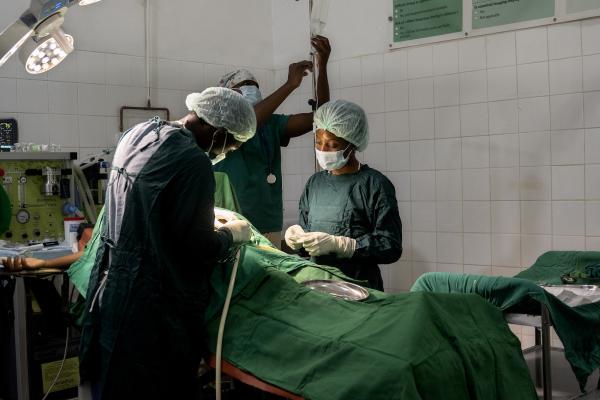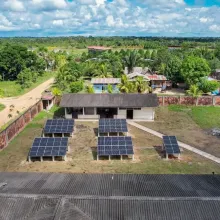It’s 1 a.m. and the power snuffs out at the remote Neno District Hospital in Malawi.
Vital operations grind to a halt. Oxygen production slows. Baby warmers, which regulate the temperature of premature or critically ill infants, will soon grow cold.
Calls are made, and hospital staff race in ambulances to the home of an electricity technician for help.
They know the length of time it takes to get the power back on can be the difference between life or death.
Both the Neno District Hospital and the Lisungwi Community Hospital are equipped with robust backup generators, installed to combat the frequent and random power outages in Malawi caused by persistent load shedding and an unstable grid.
After decades of colonial rule, Malawi gained independence from Britain in 1964 and began to take on debt to finance social programs and infrastructure projects. However, climbing out of sovereign debt can be incredibly difficult.
In the 2022-2023 fiscal year, Malawi—classified as one of the poorest countries in the world by the World Bank—spent roughly a third of its budget on debt interest payments—leaving key public services underfunded and over 70% of the Malawian population living below $2.50 a day. Despite these challenges, the country is working to expand essential infrastructure. In May, Malawi received a grant from the World Bank to expand its energy generation and storage capacity. Still, demand outweighs the load bearing capacity, resulting in frequent outages.
In a period of 53 days, staff at Abwenzi Pa Za Umoyo (APZU), as Partners In Health (PIH) is known in Malawi, counted more than 30 power outages—sometimes multiple times a day.
Still, the process of switching from grid power to generator power requires the help of a specially trained technician. The technician must run between the hospital and the building where the generator is located. It takes about 10 minutes for the technician to perform the switch—but that’s only if everything goes according to plan.
If it happens in the middle of the night, hospital staff must call the home of a sleeping technician, wake them, and have them get in a vehicle back to the hospital so the switch can be made.
“The blackouts would come at 1:00 AM and then that means looking for a driver to go and pick a staff member up,” said APZU Infrastructure Manager John Munthali. “The moment they get home, then electricity is back.”
Previously, staff tried to schedule an electricity technician at all hours—but even with the combined effort of PIH and Malawi’s Ministry of Health, or MOH, the workforce was spread thin.
And it weighed heavily on staff members, who felt a deep sense of responsibility for ensuring patients’ safety.
“Patients don’t wait for any minute,” said Munthali. “There’d be someone on an oxygen concentrator, babies on life-supporting equipment, blood samples in the laboratory, somebody undergoing a (surgery). There is a whole lot of life and death risk associated, and to put in someone’s hands—it was unfair to both those who would lose life to it and those that were being entrusted with such.”
To combat the temperamental nature of this vital technology, APZU and MOH staff worked to obtain automatic transfer switches, or ATSes, which are specialized pieces of equipment that allow the power to switch automatically between grid and generator power without the need for a technician.
Unfortunately, those switches often broke after a week or two of use, unable to handle the extreme load shedding.
“We used to have a lot of power surges that were beyond what the other automatic transfer switches could contain,” said Munthali.
For over a year, APZU staff worked alongside the MOH to procure two robust, durable ATSes with the support of PIH’s Non-Negotiables Phase 1 grant, funded through an anonymous PIH donor.
APZU and MOH staff held consultations to determine which technology would be most tailored to the hospitals’ needs, with a specific focus on long-term use that could adapt to changing technology over the next 10 to 20 years. After months of conversations and quotations, the team finalized its ATS plan.
Installation boosts oxygen production, decreases environmental impact
After more than a year of design consultations and sourcing parts, APZU and MOH staff obtained all the necessary components—with the ATSes coming all the way from South Africa, and the installation materials sourced locally in Malawi.
Despite the cost and difficulty sourcing the technology, PIH and MOH staff established ATSes in both hospitals in May and June of 2025, meaning no more middle-of-the-night wake-up calls to transfer the power, or lost oxygen production, or interrupted surgeries.
What was once an anxiety-inducing plunge into darkness has changed to a six second blink, as the grid power automatically shifts to generator power.
“It’s quite a relief,” Munthali said, smiling.
The quick shift also means the hospital can produce more oxygen for storage, a vital part of patient care, said APZU Biomedical Engineer Kingsley Gwesere. Countless conditions, including tuberculosis, asthma, heart failure, COVID-19, and pneumonia, require patients to rely on a steady supply of lifesaving oxygen.
This seamless transition between grid and generator power means the hospital can continue producing oxygen without interruption. That additional oxygen could save a patient in need, said APZU Electrical Engineer Chisomo Jeputala.
It also means a reduction in diesel usage. The switch can sense when the grid power comes back on, meaning it can quickly switch away from the diesel generator power. This fast switch will eliminate the use of an estimated 409 liters of diesel annually, reducing approximately 1.1 tons of carbon dioxide released into the atmosphere.
PIH believes that people deserve the highest quality of medical care, starting with those who need it most. Even when facing problems that seem overwhelming, PIH and our partners are committed to navigating them in a thorough, thoughtful, and patient-centered way.

